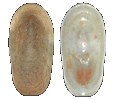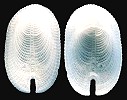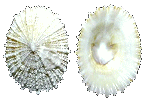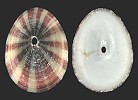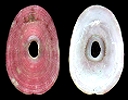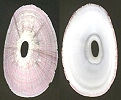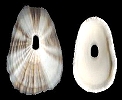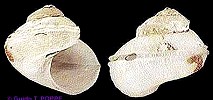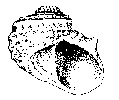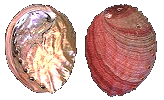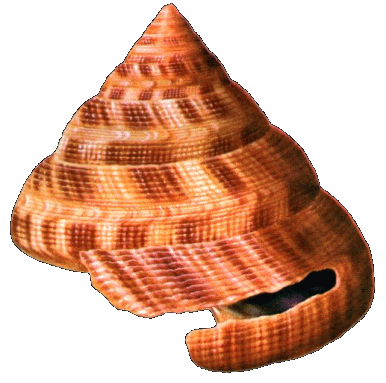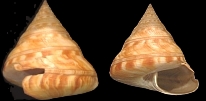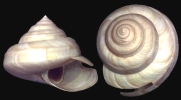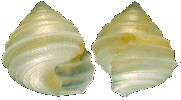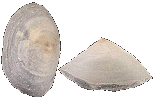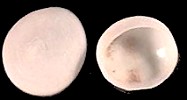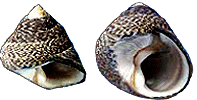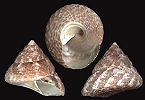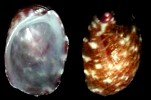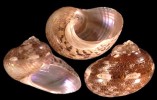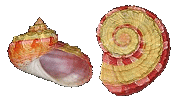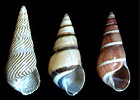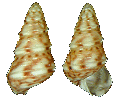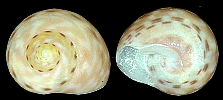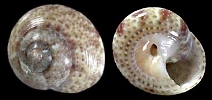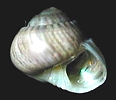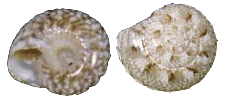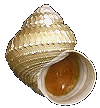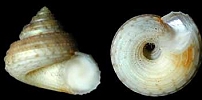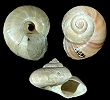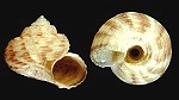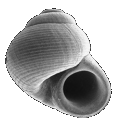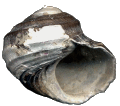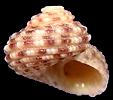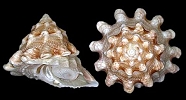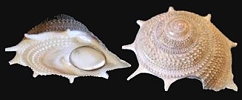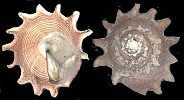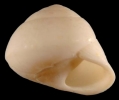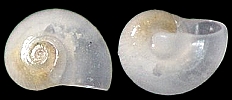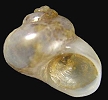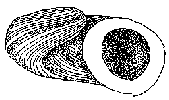|
2. Subclass:
ORTHOGASTROPODA Ponder & Lindberg, 1996
[= PROSOBRANCHIA Milne Edwards, 1848 p.p. + OPISTHOBRANCHIA;
= AZYGOBRANCHIA Spengel, 1881 p.p.]
|
| |
1.
SuperOrder: Vetigastropoda: Salvini-Pläwen, 1980
( 1 of 5 superorders) |
| |
SuperFamily:
Fissurelloidea (Keyhole limpets) |
| |
|
Family: Clypeosectidae
(from hydrothermal vents)
|
| |
Genus:
Pseudorimula, Clypeosectus
|
Unable
to Locate Image
|
Unable
to Locate Image
|
|
Pseudorimula
|
Clypeosectus
|
|
| Family:
Fissurellidae |
| |
SubFamily:
Diodorinae |
| |
Genus:
Diodora
|
|
Diadora
italica
(Defrance, 1820)
40 mm.
Tiscali
|
|
| SubFamily:
Emarginulinae
|
| |
Genus: Emarginula,
Scutus, Rimula, Puncturella, Hemitoma, Tugali, Clypidina, Zeidora, Emarginella,
Montfortula, Rixa
|
|
|
|
|
|
|
Scutus
(Scutus) antipodes
(Montfort, D. de, 1810)
25 - 125 mm
Gastropods.com
|
|
|
|
|
|
|
|
Hemitoma
(Montfortista) panhi
(Quoy, J.R.C. & J.P. Gaimard, 1834)
to 15 mm
Gastropods.com
|
|
Clypidina
rugosa
(Quoy & Gaimard, 1834)
25 mm
Kwansei
|
|
|
|
Unable
to Locate Image
|
|
|
Montfortula
rugosa
(Quoy, J.R.C. & J.P. Gaimard, 1834)
15 - 25 mm
Kwansei
|
Rixa
watsoni
|
|
|
|
| SubFamily:
Fissurellinae |
| |
Genus:
Fissurella, Macroschisma,
Amblychilepas, Lucapinella, Cosmetalepas, Medusafissurella, Dendrofissurella
|
|
|
|
|
Fissurella
(Fissurella) maxima
(Sowerby, G.B. I, 1835)
120 mm.
Gastropods.com
|
|
|
Cosmetalepas concatenatus
(Crosse, H. & Fischer, 1864)
22 mm
Gastropods.com
|
|
|
|
|
|
|
|
|
|
|
|
| |
|
|
SuperFamily:
Trochoidea |
| |
Family:
Pendromidae
|
| |
|
Genus: Pendroma,
Rugulina
|
Unable to Locate Image
|
Unable
to Locate Image
|
|
Pendroma
|
Rugulina
|
|
Family:
Trochidae
(Top Shells)
"The top shell family is very large, with hundreds of species and many
genera. Most show an iridescent interior, numerous whorls, and a horny operculum.
Varying shell characteristics have led to specification of several distinctive
subfamilies....top shell molluscs are primitive grazers that feed by rasping
algae and small detritus off rocky surfaces.... " Archerd
Collection |
| |
SubFamily:
Unplaced
|
| |
Genus: Osilinus,
Omphalius, Thaliota, Lischkeia, Infundibulops, Roya, Suchium, Zethalia,
Ginebis, Ilanga, Iheyaspira
|
|
|
Unable
to Locate Image
|
|
Osilinus
lineatus
(Syn: Monodonta lineata)
(da Costa,1778)
25 mm.
URL
|
Omphalius
nigerrimus
(Gmelin, 1791)
15 mm
Kwansei
|
Thaliota
ocellata
(Syn. Alcyna ocellata)
|
Lischkeia
crumpii
(Pilsbry, H.A., 1893)
25 mm
|
|
|
Unable
to Locate Image
|
|
Unable
to Locate Image
|
|
|
Roya
|
Suchium
Umbonium costatum
(Lesson, RP, 1831)
25 mm
Bigai.com
|
Zethalia
|
|
|
Unable
to Locate Image
|
Unable
to Locate Image
|
|
Ginebis
argenteonitens convexiusculus
(Yokoyama, M., 1920)
50 mm
Gastropods.com
|
Ilanga
|
Iheyaspira
|
|
|
| SubFamily:
Trochinae
|
| |
Genus: Trochini,
Gibbulini, Cantharidini
|
Unable to Locate Image
|
Unable to Locate Image
|
Unable to Locate Image
|
|
Trochini
|
Gibbulini
|
Cantharidini
|
|
| SubFamily:
Stomatellinae
|
| |
Genus: Stomatia,
Stomatella, Broderipia, Microtis, Synaptocochlea, Pseudostomatella, Stomatolina
|
|
|
Unable
to Locate Image
|
Unable
to Locate Image
|
|
|
|
Broderipia
|
Microtis
|
|
|
|
|
|
|
|
Pseudostomatella
papyracea
(Gmelin, J.F., 1791)
30 mm
WorldWide.com
|
|
|
|
| SubFamily:
Umboniinae
(Button top shells) |
| |
Unplaced:
Lirularia |
| Umboniini
|
| |
Genus:Umbonium
|
| Bankiviini
|
| |
Genus:
Bankivia, Leiopyrga
|
|
Monileini: |
| |
Genus:
Monilea, Camitia, Ethalia,
Isanda, Rossiteria, Ethaliella, Talopena, Ethminolia, Conotalopia, Parminolia,
Vanitrochus
|
|
|
|
|
|
|
Camitia
rotellina
(Gould, 1849)
URL
|
|
|
|
|
|
|
|
Rossiteria
nucleus
(Philippi, 1850)
Gastropods.com
Bigai
|
|
|
|
|
|
Unable
to Locate Image
|
Unable
to Locate Image
|
|
Conotalopia
sematensis (Oyama, 1942 )
Kwansei
|
Parminolia
|
Vanitrochus
|
|
|
| SubFamily:
Margaritinae |
| |
Unplaced
|
| |
Genus:
Bathybembix
|
|
Bathybembix
argenteonitens
(Lischke, 1872)
55 mm
Bigai
|
|
| Margaritini |
| |
Genus:
Margarites
|
| Kaiparathinini |
| |
Genus:
Kaiparathina
|
Unable to Locate Image
|
|
Kaiparathina
|
|
| SubFamily:
Eucyclinae |
| |
Genus:
Chilodontini, Calliotropini
|
Unable
to Locate Image
|
|
|
Calliotropini
|
Calliotropis
(Calliotropis) eucheloides
(Marshall, B.A., 1979)
10 mm
Gastropods.com
|
|
|
SubFamily:
Calliostomatinae
|
| |
Genus:
Calliostoma, Astele, Laetifautor,
Bathyfautor, Dactylastele, Selastele, Fautricini
|
|
|
|
|
|
|
|
Laetifautor
elegans
(Habe, 1960 )
5 mm
Kwansei
|
|
|
Unable
to Locate Image
|
Unable
to Locate Image
|
Unable
to Locate Image |
|
|
Bathyfautor
|
Dactylastele
|
Fautricini
|
|
|
| SubFamily:
Solariellinae |
| |
Genus: Solariella,
Minolia, Bathymophila, Spectamen, Zetela, Archiminolia, Minolops, Pagodatrochus,
Pseudominolia
|
|
|
Unable
to Locate Image
|
|
Unable
to Locate Image
|
Solariella
carvalhoi
Lopez, Al S.J. & P. Cardoso, 1958
5 - 7 mm
Gastropods.com
|
|
Bathymophila
|
|
Zetela
|
|
|
|
|
|
|
|
Archiminolia
oleacea
(Hedley, C. & W.F. Petterd, 1906)
to 18 mm
Gastropods.com
|
|
Pagodatrochus
variabilis (H.Adams, 1873)
to 3 mm
Bigai
|
|
|
|
| SubFamily:
Halistylinae
|
| |
Genus: Charisma,
Botelloides
|
|
Unable
to Locate Image
|
|
|
Botelloides
|
|
| SubFamily:
Tegulinae
|
| |
Genus:Tegula
|
| SubFamily:
Cataeginae |
| |
Genus: Cataegis
|
| SubFamily:
Thysanodontinae |
| |
Genus: Carinastele,
Thysanodonta, Herbertina
|
|
Unable
to Locate Image
|
Unable
to Locate image
|
|
|
Thysanodonta
|
Herbertina
|
|
| Family:
Turbinidae
|
| |
SubFamily:
Angariinae
|
| |
Genus: Angaria
| |
 |
|
Angaria
delphinulus aculeata
(Reeve, L.A., 1842)
30 - 50 mm
Gastropods.com
|
|
| SubFamily:
Colloniinae |
| |
Genus: Homalopoma,
Argalista, Collonista, Bothropoma, Leptocollonia, Parisanda
|
|
Unable
to Locate Image
|
|
|
|
Argalista
|
|
|
Unable to Locate Image
|
Unable to Locate Image
|
Unable to Locate Image
|
|
Bothropoma
|
Leptocollonia
|
Parisanda
|
|
| SubFamily:
Gabrieloninae |
| |
Genus: Gabrielona
|
Unable to Locate Image
|
|
Gabrielona
|
|
| SubFamily:
Liotiinae |
| |
Genus: Liotia,
Arene, Liotina, Pseudoliotina, Munditia, Dentarene, Austroliotia, Liotinaria,
Circumstella, Bathyliotina
|
|
|
|
Unable
to Locate Image
|
Unable
to Locate Image
|
Liotia
echinacantha
(Melvill, J.C. & R. Standen, 1903 )
8 mm
Gastropods.com
|
Arene
boucheti
(Leal, J.H.N.) 1991 to 6 mm
Gastropos.com
|
|
Pseudoliotina
|
Munditia
|
|
|
|
Unable
to Locate Image
|
Unable
to Locate Image
|
|
|
|
Austroliotia
australis
(Kiener, L.C., 1839)
10 mm
Gastropods.com
e
Image
|
Liotinaria
|
Circumstella
|
|
|
| SubFamily:
Phasianellinae
|
| |
Genus: Phasianella
|
|
Phasianella
australis
(Gmelin, J.F., 1791)
50 - 100 mm.
Gastropods.com
|
|
| SubFamily:
Tricoliinae
|
| |
Genus: Tricolia
|
| SubFamily:
Turbininae
|
| |
Genus: Turbo,
Astraea, Astralium, Bolma, Guildfordia, Pomaulax
|
|
|
|
|
|
|
|
|
|
|
|
Bolma
(Harisazaea) girgyllus
(Reeve, L.A., 1861)
50 mm.
Gastropods.com
|
Guildfordia
Guildfordia aculeatus
(Kosuge, S., 1979)
40 - 50 mm
Gastropods.com
|
|
|
| SubFamily:
Homalopomatinae |
| |
Genus: Phanerolepida,
Thermocollonia
|
Unable to Locate Image
|
Unable
to Locate Image
|
|
Phanerolepida
|
Thermocollonia
|
|
| SubFamily:
Unplaced |
| |
Genus: Cantrainea
|
|
Cantrainea
macleani
( Warén & Bouchet, 1993)
17 mm.
JaxShells
|
|
| Family:
Skeneidae
|
| |
|
Genus: Cyclostrema,
Daronia, Tubiola, Crossea, Putilla, Leucorhynchia, Cirsonella, Brookula,
Microdiscula, Liotella, Lissotesta, Zalipais, Lophocochlias, Lodderena,
Chunula, Partubiola, yclostremiscus, Eudaronia, Liocarinia, Rotostoma,
Callodix, Helisalia, Microcarina, Munditiella, Tholostoma, Xyleptogyra,
Bathyxylophila, Bruceiella, Ventsia
|
|
|
|
|
|
|
|
|
|
|
|
|
Unable to Locate Images for the following genus
|
| |
|
|
|
|
|
Daronia
|
Tubiola
|
Putilla
|
Brookula
|
Microdiscula
|
|
Liotella
|
Lissotesta
|
Zalipais
|
Lophocochlias
|
Chunula
|
|
Partubiola
|
yclostremiscus
|
Eudaronia
|
Liocarinia
|
Rotostoma
|
|
Callodix
|
Helisalia
|
Microcarina
|
Munditiella
|
Tholostoma
|
|
Xyleptogyra
|
Bathyxylophila
|
Bruceiella
|
Ventsia
|
|
|
| Family:
Trochaclididae
|
| |
|
Genus: Trochaclis,
Acremodonta, Acremodontina, Austrotrochaclis
|
Unable
to Locate Image
|
Unable
to Locate
Image
|
Unable
to Locate
Image
|
Unable
to Locate
Image
|
|
Trochaclis
|
Acremodonta
|
Acremodontina
|
Austrotrochaclis
|
|


